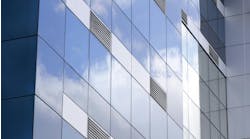Inefficient chillers can create a real financial hurdle during warmer months, and it’s not just because you’re using the equipment more. Excess lift may be wasting HVAC energy without you even realizing it.
Lift refers to the temperature difference between the hot water leaving your condenser and the cold water leaving your chiller to circulate through your building.
In other words, lift shows you how much work the chiller’s compressor has to do in order to get rid of the heat and drop the refrigerant to your desired temperature. Less effort by the compressor means your chiller consumes less energy, which ultimately saves you money.
Understanding Chiller Lift
Truly understanding lift means first understanding the basics of how chillers exchange heat to keep your building cool.
Building return water flows into the evaporator, where it’s cooled by liquid refrigerant, explains Brant Holeman (pictured), mechanical engineer and commissioning authority coordinator for RTM Engineering Consultants. The refrigerant absorbs the heat from the water, and the chilled water is circulated into your building to cool it down.
[Related: Trending: Individual HVAC Control]
Meanwhile, the now warmed refrigerant evaporates into the compressor, which compresses the refrigerant vapor back into a liquid and sends it into the condenser.
The condenser cools the liquid refrigerant through a process of heat rejection, which relies on outdoor fans and coils for air-cooled chillers, or a cooling tower, or dry cooler for water-cooled units. The condenser uses an expansion valve to regulate how much of the cold refrigerant is released into the evaporator to meet your cooling needs.
Lift is determined by subtracting the temperature of the chilled water going out to your building (typically 42-46 degrees F.) from the temperature of the water that’s leaving the condenser to be cooled by a cooling tower or fans (usually around 85-95 degrees F.). Lift can range anywhere from 5-50 degrees F. depending on the equipment and design conditions, Holeman says.
The term lift can also be used to describe a chiller’s operating pressures in place of its temperatures.
“The common energy losses in a chiller have to do with small incremental losses from the different components that make up the chiller, but the biggest one is excess lift,” Holeman explains. “This can be due to the original design plan, or maybe you’re not using the chiller to its full potential because you have certain institutional goals, or you have setpoints you’re used to using from other facilities from force of habit or old operational issues. Sometimes people will drop the chilled water temperature because they’re trying to get the coldest water out to the coils for humidity control.”
Strategy No. 1: The Chilled Water Reset
One way to reduce lift is to reset the temperature of the chilled water supply that cools your building. Raising this number by just 2 degrees F. means your compressor doesn’t have to run as hard or as often, which saves energy, Holeman explains.
[On topic: 3 Tips to Integrate Better HVAC Controls]
One way to do that is to change your cooling coil control valve positions. The valves limit how much chilled water flows through each coil.
Holeman recommends that the reset strategy focus on whichever coil is in the space with the most critical cooling demand – for example, a school during lunch would have the most demand coming from the cafeteria, since that’s where the most students are. Increase the supply temperature by just a few degrees, then look at coil positions.
“What we’re going to do is command the building automation or chiller control system to open the cafeteria valve as much as we can. Once that’s at its 100 percent position, we’re going to open the other valves up so they can continue to work with warmer temperature water,” Holeman explains.
[Smart Sensor Technology: Reducing HVAC Energy Use]
“If we use warmer water, we’re going to need more of it to do the same conditioning job. In a chilled water reset scheme like this, you also want to set some upper and lower bounds. Maybe you don’t want the supply water temperature to go all the way up to 60 degrees because that doesn’t work very well for humidity control, so you’d say ‘I don’t want to go colder than 42 or warmer than 48 or 50.’ Whatever makes sense for your facility,” he says.
Strategy No. 2: The Condenser Reset
Another option is to target the water entering your condenser water, Holeman explains.
“That comes down to turning on more fans or building a larger tower when you’re first designing,” Holeman says.
“Depending on your design conditions, you can lower the temperature of what’s leaving the condenser but reject the same amount of heat. It’ll be more efficient because it’s 80 degrees coming back to the condenser with less lift. Assuming the same flow rate, if I can get colder water from my tower because it’s more robustly designed or because the outside air wet bulb is low, I can drop that lift by 5 degrees. That’s less work the compressor has to do.”
Automation software will generally let you instruct your chiller system to increase fan speed or stage on more fans as the outside air wet bulb temperature increases to compensate for the additional heat and humidity, Holeman adds.
Has this been helpful? Watch this Buildings Education online course with Brant Holeman on-demand and get CE credits: Achieve Better Chill Control
“If we’re controlling the speed of the tower fan, it’s not changing the setpoint, it’s just adjusting the fan speed based on the ability to evaporate water into the atmosphere,” Holeman says.
He continues, “If you’re in Miami, it’s going to be harder to evaporate water into the outside air than if you’re in the mountains. If you ignore outside air wet bulb with respect to your reset strategy, not your fan speed or tower operation, but just the temperature you’re bringing back to your condenser, that’s more consistent across geographies.”
Two handpicked articles to read next:



